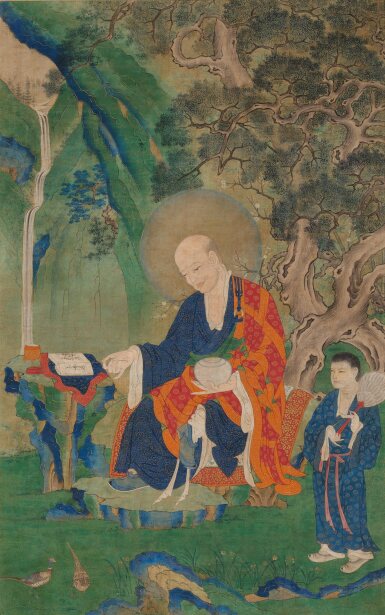Indian and Himalayan Art, including Masterpieces from the Nyingjei Lam Collection
Indian and Himalayan Art, including Masterpieces from the Nyingjei Lam Collection

A painting of Pindola Bharadvaja, Tibet or China, 15th century
Auction Closed
March 21, 04:25 PM GMT
Estimate
200,000 - 300,000 USD
Lot Details
Description
A painting of Pindola Bharadvaja
Tibet or China, 15th century
The inscription on the front of the painting reads:
(g.yon drug pa bar a sdo tsa bsod gnyong len / “6th [from] the left. Piṇḍolabharadvāja”)
The inscription on the reverse reads:
(g.yon drug pa bha ra dhwa dza bsod snyoms len / “6th [from] the left. Piṇḍolabharadvāja”)
Himalayan Art Resources item no. 24669.
HAR編號24669
Height 30¾., 78 cm: Width 19¾ in., 50 cm
Schoettle, Stuttgart, 1969.
Collection of Dr. Hans Werner Riedel and Dr. Ralf Dieter Loher-Riedel.
The arhat Pindola Bharadvaja is dressed in elegant silk robes and seated on a rocky outcrop spread with a richly patterned textile. A slippered foot rests on a ledge below with his left leg drawn up supporting the weight of the alms bowl in his left hand. A baton in his right hand points to the text of an open sutra placed on an outcrop together with a silk sutra cover, a tripod censer and a red covered box. An attendant stands to the side holding a fly whisk, and a pair of pheasants engage in the foreground. Gnarled trees and bamboo grow in blue and green landscape, with mountains and a waterfall in the distance. A Tibetan inscription records the arhat’s name, Pindola Bharadvaja, and the position of the painting in a set, sixth from the left.
The composition of the painting is derived from Yongle period (1403-1424) prototypes such as the Cudapanthaka in a private collection, see Marsha Weidner, ed., Latter Days of the Law: Images of Chinese Buddhism 850-1850, 1994, pl. 10, cat. 21, and the Vanavasa in the Robert Rosenkranz Collection, in James C. Y. Watt and Denise Patry Leidy, Defining Yongle: Imperial Art in Early Fifteenth-Century China, 2005, pl. 37, in which the arhats appear in intimate and richly detailed settings of classical blue-green landscape and trees, with attendants and mythical animals. The style had a seminal influence on the depiction of arhats in Tibetan and Sino-Tibetan painting. While the Yongle examples are on silk, this painting has a cotton support that might indicate a Tibetan provenance. Indeed the script of the opened sutra is Tibetan, although the book is in the concertina format favored in China. The masterful execution of classical Chinese detail in the blue and green landscape with delicate gold highlights, the gnarled trees, luxurious patterned silks, and subtle plumage of the male and female pheasants, perhaps suggests the work of a Chinese artist. The sensitive rendering of Pindola’s face, which is closer in style to the Yongle originals than many of the Tibetan copies considered to be late fifteenth, or perhaps sixteenth century, ibid, pls. 40, 41, and Rob Linrothe, Paradise and Plumage: Chinese Connections in Tibetan Arhat Painting, 2004, pl. 7, suggests a fifteenth century date for this fine and early arhat painting.
賓度羅跋羅墮羅漢身披長袍,坐於石上,石上坐墊紋飾精美,藏文題款記載此為賓度羅跋羅墮羅漢,並標明此畫是一組畫當中,從左至右第六幅。
本畫構圖源自明永樂年雛本,一例刻劃芭蕉羅漢,出自Robert Rosenkranz收藏,載於 James C. Y. Watt 及 Denise Patry Leidy,《Defining Yongle: Imperial Art in Early Fifteenth-Century China》, 2005年,圖版37,畫中羅漢背後景物屬傳統書畫青綠山水,並畫樹木、侍從及靈獸。這種風格對西藏羅漢畫像發展有著重要影響。永樂年的作例為絹本,本畫則以棉質物料托底,或可憑此推斷本作源自西藏,而經文為藏文,折頁書冊則流行於中土。 本畫青綠山水屬於傳統書畫技法,配以金彩勾勒,從樹木形態、絲綢華麗紋飾,以及鳥兒羽毛含蓄色調來看,本畫有可能出自中國畫師之手。與十五世紀末或十六世紀西藏複製本比較,本畫芭蕉羅漢面容刻劃筆法細膩,更接近永樂年作例,前述出處,圖版40及41。根據Rob Linrothe,《Paradise and Plumage: Chinese Connections in Tibetan Arhat Painting》,2004年,圖版7,本畫或可斷代十五世紀。
